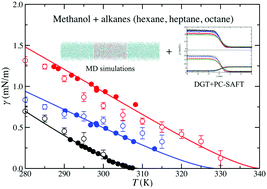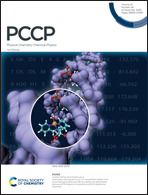Molecular modelling techniques for predicting liquid–liquid interfacial properties of methanol plus alkane (n-hexane, n-heptane, n-octane) mixtures
Abstract
In this work, the liquid–liquid interfacial properties of methanol plus n-alkane (n-hexane, n-heptane, n-octane) mixtures are investigated at atmospheric pressure by two complementary molecular modelling techniques; namely, molecular dynamic simulations (MD) and density gradient theory (DGT) coupled with the PC-SAFT (perturbed-chain statistical associating fluid theory) equation of state. Furthermore, two molecular models of methanol are used, which are based on a non-polarisable three site approach. On the one hand, is the original (flexible) TraPPE-UA model force field. On the other hand, is the rigid approximation denoted as OPLS/2016. In both cases, n-alkanes are modelled using the TraPPE-UA model. Simulations are performed using the direct coexistence technique in the  ensemble. Special attention is paid to the comparison between the estimations obtained from different methanol models, the available experimental data and theoretical calculations. In all cases, the rigid model is capable of predicting the experimental phase equilibrium and interfacial properties accurately. Unsurprisingly, the methanol-rich density and interfacial tension are overestimated using the TraPPE model combined with Lorentz–Berthelot mixing rules for predicting the mixture behaviour. Accurate comparison between MD and DGT plus PC-SAFT requires consideration of the cross-interactions between individual influence parameters and fitting the βij values. This latter aspect is particularly important because it allows the exploitation of the link between the EOS model and the direct molecular simulation of the corresponding fluid. At the same time, it was demonstrated that the key property defining the interfacial tension value is the absolute concentration of methanol in the methanol-rich phase. This behaviour indicates that there are more hydrogens bonded with each other, and they interact favourably with an increasing number of carbon atoms in the alkane.
ensemble. Special attention is paid to the comparison between the estimations obtained from different methanol models, the available experimental data and theoretical calculations. In all cases, the rigid model is capable of predicting the experimental phase equilibrium and interfacial properties accurately. Unsurprisingly, the methanol-rich density and interfacial tension are overestimated using the TraPPE model combined with Lorentz–Berthelot mixing rules for predicting the mixture behaviour. Accurate comparison between MD and DGT plus PC-SAFT requires consideration of the cross-interactions between individual influence parameters and fitting the βij values. This latter aspect is particularly important because it allows the exploitation of the link between the EOS model and the direct molecular simulation of the corresponding fluid. At the same time, it was demonstrated that the key property defining the interfacial tension value is the absolute concentration of methanol in the methanol-rich phase. This behaviour indicates that there are more hydrogens bonded with each other, and they interact favourably with an increasing number of carbon atoms in the alkane.



 Please wait while we load your content...
Please wait while we load your content...